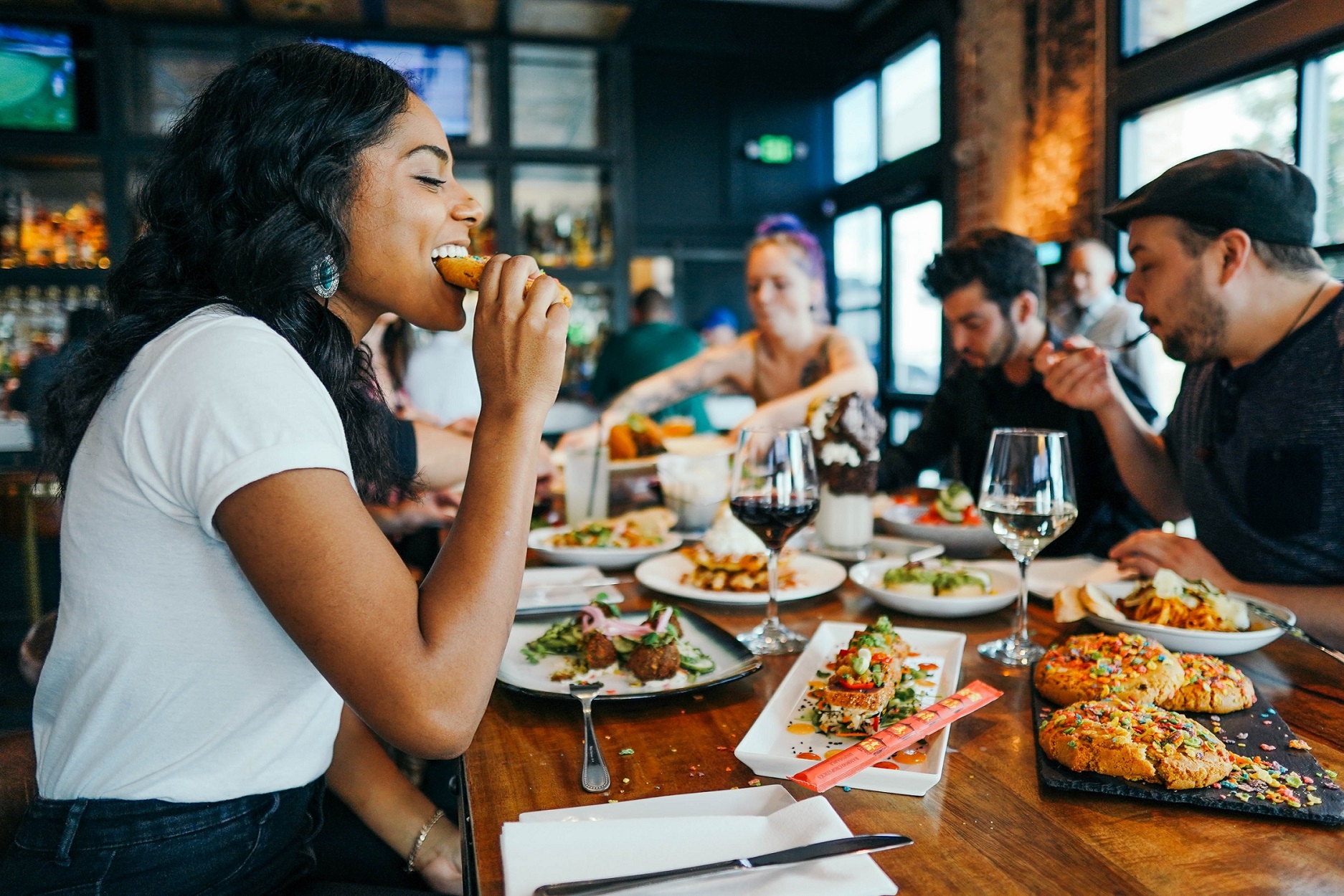COVID-19 hit the restaurant industry hard, with many establishments closing temporarily- or worse, permanently. This pattern has caused restaurants to increase online marketing efforts and stick to safety protocols, among other things. With this approach, they can slow the spread of the disease while also profiting.
Restaurants are facing difficult circumstances, but as many have reopened, proprietors have used their inventiveness to make the situation more acceptable. These innovative endeavors have the potential to establish the standard in the near future. Meanwhile, aspiring chefs took this terrible tragedy as an opportunity to deliver their specialties to their local communities. And considering that food is a basic requirement, this has worked for them. In this article, we’ll discuss 9 restaurant trends that experts believe will affect the restaurant business in 2023, ranging from the continued rise of meal deliveries to the emphasis on hygiene.
Despite reopenings, many restaurants struggled, with 90% of full-service establishments reporting sales decreases and a 36% average revenue drop (Seattle Times, 2020). Not everyone wants to eat out unless there is a stronger assurance of their safety. However, this does not spell the end of the food and beverage industry. From these quandaries emerge new trends that may very well see dining places through the pandemic.
People are Valuing Cleanliness and Health More
Given the proliferation of COVID-19, sanitation is critical. The National Restaurant Association has issued safety guidelines for restaurant reopenings and one of the report’s main topics is sanitation (National Restaurant Association, 2020). Kitchen staff workstations, restaurant chairs and tables, restrooms, and other restaurant fixtures should all be completely sterilized, more so now due to the pandemic.
Furthermore, the cleaning campaign extends to kitchen staff personal hygiene as well. Members of the kitchen crew should use hand sanitizers with an alcohol level of at least 60% in addition to handwashing on a regular basis (National Restaurant Association, 2020). Along with social distancing measures, sanitizers should be readily available to all guests to reduce the risk of getting COVID-19.
These safety regulations are consistent with diners’ concerns. According to an OpenTable survey, 72% of guests believe that tight cleanliness practices in restaurants are extremely important (OpenTable, 2020). Diners are more concerned than ever with health and sanitation, with 93% placing a high value on handwashing and 58% placing a high value on the use of hand sanitizers (OpenTable, 2020). With COVID-19 still in effect today, this campaign for sanitation and safety will be widespread in eateries in the next years.
Fast-Casual Dining Will Continue to Thrive
Despite the ongoing pandemic, current restaurant food patterns imply that fast-casual companies will thrive. This segment is predicted to generate $931.7 billion in total revenues by 2027 (Business Wire, 2020). However, there will be adjustments. Fast-casual restaurants, for example, are now expected to deliver better-tasting cuisine in a limited-service format.
Furthermore, with 32% of customers ordering for takeout, 9% ordering for pickup, and 10% ordering through delivery services, it is safe to say that these restaurants are gradually leaning toward making it simpler for customers to take their favorite meals home with them. Fast-casual restaurants such as Panera Bread and Chipotle Mexican Grill have risen by 550% since 1999 (Technomic, 2019). Furthermore, experts anticipate that the segment will continue to expand. And it will expand much further if it fully utilizes online delivery services to mitigate the consequences of the COVID-19 lockout.
Food Delivery Services are King
People have developed the practice of having food delivered rather than dining out since the outbreak caused lockdowns and limited movement. 62% of consumers choose food deliveries, a 52% increase from pre-pandemic levels (OpenTable, 2020). Furthermore, food delivery has grown so popular that the business is predicted to be worth $154.34 billion by 2023 (Business Wire, 2020).
In lieu of this, restaurants have begun to shift their attention away from the conventional dining experience and toward delivering food to their customers’ homes. The restaurant market’s proportion of food delivery is 14%, and it is expected to expand to 21% by 2025 (Morgan Stanely, 2020). This means that businesses that aren’t recognized for food deliveries, such as pubs and fine dining facilities, are likely to enter the rapidly expanding food delivery industry.
This growth is being driven by an increase in the number of delivery alternatives. New food delivery services, mobile apps, and online ordering systems are among them. Integrating a high-quality POS system with delivery operations is critical for success in this context.
Are Robochefs the New Chefs?
Now, let’s talk about how technology is transforming the way food is prepared. AI-powered devices that can cook any cuisine have been created in recent years. Actually, robochefs such as Moley and Cooki (Herox, 2021) have been creating delectable meals since the early 2010s. Their commercial application has just lately increased. The procedure included computerized cooking. It is comparable to other automation technologies, such as marketing automation systems. It entails a novel and sophisticated human activity: cooking. Cooking is done automatically by sophisticated robots. These robochefs can cook with great precision, flavor, and cleanliness. This breakthrough concept attempts to produce safer, cleaner food that is also fast and requires no physical labor.
Challenges With Staffing
Overall restaurant and foodservice employment was projected to reach 15 million in 2019 (RAMW, 2019). Because of this huge tendency, restaurant owners must address personnel recruiting and retention as important difficulties. However, COVID-19 presented an even greater obstacle. In the United States alone, 372,000 restaurant staff lost their jobs in January 2021 (Restaurant Business, 2021).
Annual turnover rates in the industry range from 100% to 130% on average (CNBC, 2019). Meanwhile, experts estimate that turnover costs exceed $2,000 per employee (Blackbox Intelligence, 2019). As a result, excessive personnel turnover will be one of the most difficult operational difficulties for restaurants in 2020 (Zenput, 2020). Most operators prioritize filling the most difficult back of the house (BOH) positions. BOH positions include chefs, kitchen supervisors, expeditors, and dishwashers.
Self-Serve Kiosks on The Rise
Self-ordering kiosks are another hot automation tech idea for restaurants (Forbes, 2019). These touch-screen machines shorten queues and offer a variety of benefits, mostly to QSRs and fast-casual restaurants. This is consistent with current social distancing practices. The main change in self-service kiosk usage is that 40% of restaurants have elected to clean their kiosks more frequently (Technomic, 2020). This cutting-edge touch-screen technology attempts to speed up the ordering procedure. It also provides clients with an innovative approach to order food. This gives people more freedom to customize meals exactly as they want it.
During their first year of operation, these self-service kiosks could increase revenues by 5% or 6% (Big Think, 2018). Following McDonald’s $2.4 billion “Experience of the Future” concepts in 2018, others followed suit. Global demand is rising. Tillster (2019) predicts that the worldwide kiosk market would be worth $30.8 billion by 2024.
The Rise of Health-Conscious Dining
When dining al fresco, an increasing number of people are opting for healthier options. A rising percentage of consumers desire healthful foods that satisfy their stomachs while also boosting their immunity. After all, a more powerful immune system may aid in the fight against COVID-19.
Functional meals are becoming increasingly popular as their names appear on more restaurant menus. It’s no longer a niche market. The global functional foods market will expand from $177.77 billion in 2018 to $267.92 billion by 2025 (Allied Market Research, 2020). The reasons behind their extraordinary rise are compelling. Aging, rising interest in diet-based wellbeing, mounting healthcare expenditures, and technology advancements are among them.
Popularity of Limited Time Offers
Perhaps it was McDonald’s Cheesy Bacon Fries that piqued your interest. Was that a Tie-Dye Frappuccino from Starbucks? Many LTOs have recently found success among today’s consumers. This is why they are being used increasingly frequently by operators. 64% of the top 500 restaurant and retail chains have grown their limited-time menu offerings in the last five years (Restaurant Business, 2019). As a result, LTOs are now more successful at driving traffic. Many restaurants do LTO-related market research to investigate strategies to introduce more restricted menu items.
Experimenting with the Dining Experience
The restaurant sector is already brimming with delectable meals and brilliant dining concepts. Diners are becoming more sophisticated and difficult to please with each passing day. Whether on lockdown or in a restaurant, these inventive approaches on food are pleasurable. How can established and new eateries differentiate themselves from the competition?
Expect more restaurants to continue to gravitate toward providing out-of-the-box experiences for their guests this year. Sure, LTOs and daily deals have grown hugely popular. Consumers are always open to new and unusual products that can surprise them. Prior to COVID-19, welcome to a hot trend in the dining universe: dining as an experience (Single Platform, 2021).
How to Keep up with 2023’s Restaurant Trends
Great food and excellent customer service will never go out of style in the restaurant industry. Trends are constantly visible on the horizon. Despite the presence of COVID-19, restaurateurs are constantly looking for methods to keep the cash registers ringing. People had upped the ante by calling for greater transparency in restaurant operations. Healthy eating remains popular, since many people increasingly use food as medicine. Wellness food advocates have entered the debate. As seen by the rapid expansion of fast-casual restaurants and food delivery services, speed, quality, and convenience are important. LTOs and immersive dining experiences are on the rise.
New technology, like as self-service kiosks and robochefs, have proven to be effective among restaurant patrons. It will also be crucial to use mature technologies, such as some of today’s best restaurant management software. Operators must successfully address the significant workforce turnover to preserve the success of these interesting trends. Restaurant operators must stay current on new and emerging trends in order to flourish and succeed. It’s the ideal approach to provide regulars with an exceptional eating experience while also attracting potential consumers looking for a new dining adventure.




